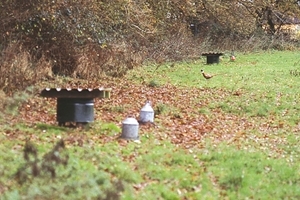 Supplementary feeding is important for pheasants throughout the autumn and winter. This is often done by scattering grain along short sections of woodland rides. Sometimes parts of the ride are covered with straw to encourage foraging behaviour. This practice should not take place on herb-rich rides in ancient woodland, where valuable plant communities can be smothered.
Supplementary feeding is important for pheasants throughout the autumn and winter. This is often done by scattering grain along short sections of woodland rides. Sometimes parts of the ride are covered with straw to encourage foraging behaviour. This practice should not take place on herb-rich rides in ancient woodland, where valuable plant communities can be smothered.
Recommendations
- Feed birds from hoppers rather than on the ground. We recommend many small hoppers in clusters rather than large single hoppers. This reduces competition between pheasants and hence straying.
- Encourage birds out of the woods by providing edge habitat and associated game crops. Game crops can be planted alongside the woodland edge or some distance away depending on the management objectives.
- In many woods, leaf litter from broadleaf trees should create the same effect as straw and work just as well.
- If straw is used, avoid herb-rich areas and rake up and remove it at the end of winter. Locate strawed areas in areas of low conservation value, cutting new rides if necessary. New rides should not be created within ancient woods without first seeking advice. Widen rides to create a strip where no straw is used.
- To encourage released birds to breed and hence contribute to wild stocks, move feed hoppers outside the woodland edge or along nearby hedgerows in spring. Spread them out into the territories of displaying males ensuring that all breeding females have access to them.
- Minimise damage and disturbance to woodland soils. Vehicles using rides on a regular basis during a wet winter may do greater damage than the pheasants.
- Avoid straw in all areas of nature conservation interest. If bales have to be used for shelter, site them in adjacent fields rather than the woodland edge.
GWCT Gamekeeper Membership - Join online today
Pay monthly
Pay annually